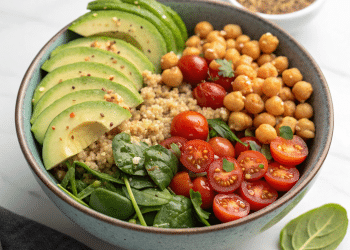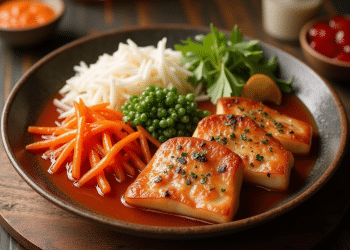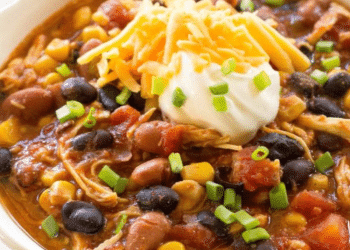Everyone has their go-to dishes that bring warmth, nostalgia, and a sense of home. These meals are more than just sustenance—they’re an emotional experience. Comfort food is like a cozy blanket for the soul, providing reassurance through familiar flavors and aromas.
What Defines Comfort Food?
The Emotional Connection to Food
Comfort food connects us to our emotions. Whether it’s the chicken soup that made you feel better as a kid, or the pie that your grandmother always baked, these dishes bring back a flood of memories and feelings. Often, they serve as a coping mechanism, offering solace in times of stress.
How Comfort Food Varies Across Cultures
Every culture has its own comfort foods, shaped by regional ingredients, traditions, and climates. For example, in the United States, mac and cheese or mashed potatoes may top the list, while in Japan, a comforting bowl of ramen or miso soup does the trick. Comfort food is a universal concept but varies greatly depending on where you’re from.
The History Behind Comfort Foods
The Origins of Popular Comfort Dishes
Many comfort foods originated during times of scarcity or hardship. For instance, dishes like stews, casseroles, and bread puddings were born out of the need to use leftovers and simple, inexpensive ingredients.
How Historical Events Shaped Comfort Foods
From wars to economic downturns, history has played a big role in shaping comfort foods. In times of difficulty, people often turn to food for a sense of normalcy, resulting in hearty, filling dishes that can be made with what’s available.
Top Comfort Food Ingredients
Common Ingredients That Create the Comfort Factor
The heart of comfort food lies in its ingredients—simple, hearty, and familiar. Staples like potatoes, cheese, butter, cream, and bread are often the backbone of classic comfort dishes. These ingredients are not only accessible but also versatile, making them perfect for creating dishes that feel indulgent yet homely. For example, mashed potatoes, mac and cheese, or a warm loaf of freshly baked bread all share a common thread: they rely on easily accessible ingredients that most households have on hand.
Why Simple Ingredients Evoke a Sense of Warmth
There’s something inherently soothing about simple, uncomplicated ingredients. Many of these ingredients—like potatoes, pasta, and butter—have been around for generations, passed down through family recipes, reminding us of home-cooked meals. They evoke feelings of nostalgia and safety, which is why comfort foods, made from these pantry staples, provide more than just physical nourishment—they also feed our emotional needs.
The Role of Nostalgia in Comfort Food
How Childhood Memories Influence Comfort Food Choices
For many people, comfort food is intrinsically tied to their childhood. The meals they ate growing up, often prepared by loved ones, become sources of comfort as adults. For instance, a bowl of chicken noodle soup may bring back memories of being cared for when sick, while a slice of apple pie might remind you of family holidays. Childhood is a time when food becomes intertwined with care and affection, which is why those early experiences shape our comfort food preferences.
The Role of Family Traditions
Family traditions also play a big role in what we consider comfort food. For some, a specific dish prepared only during the holidays becomes a comforting reminder of family gatherings. Over time, these recipes are passed down through generations, becoming symbols of continuity and stability. Whether it’s grandma’s famous lasagna or your mom’s signature meatloaf, these traditional family recipes are what many people turn to in times of stress or uncertainty, looking for that familiar taste of home.
Best Comfort Food for Every Season
Warm and Hearty Winter Comfort Foods
When the weather turns cold, we naturally gravitate towards warm, hearty dishes that provide both physical and emotional warmth. Winter comfort foods are often rich and filling, like stews, casseroles, and roasts. Dishes like beef stew, chicken pot pie, and creamy soups are popular choices during the winter months, offering both warmth and sustenance. These meals are designed to nourish the body and lift the spirit during the cold, dark days of winter.
Light and Fresh Summer Comfort Foods
Comfort food isn’t just for the colder months. During summer, comfort foods tend to be lighter and fresher, focusing on seasonal ingredients. Salads, grilled vegetables, and lighter pasta dishes become go-to options for comfort. For example, a fresh tomato and basil pasta, or a grilled corn on the cob, can evoke the carefree feelings of summer, offering a sense of relaxation and ease.
Global Comfort Foods
American Comfort Food Staples
In the United States, comfort food staples are often rich, indulgent, and carb-heavy. Favorites like mac and cheese, fried chicken, mashed potatoes, and apple pie hold a special place in the hearts of many Americans. These dishes are not only filling but are often tied to holidays, family gatherings, and celebrations, making them even more comforting.
Comfort Foods from Asia, Europe, and Beyond
Comfort food is a global concept, and every culture has its own set of dishes that evoke warmth and nostalgia. In Italy, risotto and lasagna are quintessential comfort foods, while in Japan, a steaming bowl of ramen or miso soup can bring solace. In India, dishes like dal and biryani provide comfort with their rich, aromatic spices. From hearty European stews to spicy Asian curries, comfort food varies greatly from one culture to another but shares the common goal of bringing joy and comfort through food.
The Health Benefits and Drawbacks of Comfort Food
The Psychological Benefits of Comfort Eating
Comfort food is often associated with emotional eating, and there’s a good reason for that. Studies show that eating comfort food can trigger the release of feel-good hormones like serotonin and dopamine, providing a temporary sense of happiness and relief. This is why people tend to crave comfort food when they’re feeling down, stressed, or nostalgic. It serves as a way to self-soothe, offering a brief escape from the pressures of daily life.
Balancing Comfort Foods with Nutrition
While comfort food can provide emotional benefits, it’s important to balance indulgence with nutrition. Many comfort foods are rich in calories, fats, and sugars, which can lead to health issues if consumed in excess. However, by incorporating healthier ingredients or finding lighter versions of classic dishes, you can enjoy comfort food without the guilt. For example, swapping heavy cream for a lighter alternative or using whole grains in place of refined carbs can make a big difference in the nutritional content of your favorite comfort foods.
The Evolution of Comfort Food in Modern Cuisine
How Chefs Are Reinventing Classic Comfort Dishes
In recent years, chefs around the world have started reinventing classic comfort foods, elevating them to gourmet status. Traditional dishes like mac and cheese or fried chicken are being transformed with the addition of premium ingredients like truffle oil, artisanal cheeses, or free-range meats. This blending of comfort food with fine dining has brought new life to old favorites, making them trendy while maintaining their nostalgic appeal.
Modern Takes on Traditional Comfort Food
The rise of modern comfort food also includes healthier and more sustainable versions of classic dishes. Many chefs are experimenting with plant-based alternatives, gluten-free options, and farm-to-table ingredients to create dishes that are both comforting and health-conscious. For example, cauliflower mac and cheese or sweet potato fries offer a lighter twist on traditional favorites, without compromising on flavor or satisfaction.
Easy Homemade Comfort Food Recipes
Simple Recipes for Beginners
You don’t need to be a professional chef to create comforting dishes at home. Many classic comfort food recipes are simple, require minimal ingredients, and can be made with basic kitchen tools. Here are a few beginner-friendly recipes that deliver maximum comfort with minimal effort:
- Classic Grilled Cheese Sandwich: Butter two slices of bread, place your favorite cheese between them, and grill until golden brown. Pair it with tomato soup for the ultimate cozy meal.
- Macaroni and Cheese: Boil elbow macaroni and mix with a rich, creamy cheese sauce made from butter, milk, and cheddar cheese. For an extra touch, bake it in the oven with breadcrumbs on top.
- Mashed Potatoes: Boil potatoes, mash them with butter and cream, and season with salt and pepper. It’s a simple but deeply satisfying side dish that pairs well with a variety of main courses.
Time-Tested Recipes Passed Down Through Generations
Some comfort food recipes are passed down from generation to generation, becoming treasured family traditions. These dishes often have stories attached to them, evoking memories of family gatherings and holidays. Here are a few classic recipes that have stood the test of time:
- Chicken Pot Pie: A flaky, buttery pie crust filled with creamy chicken and vegetables is a beloved dish in many households. It’s a meal that feels like a warm hug on a cold day.
- Beef Stew: Slow-cooked beef, potatoes, carrots, and onions in a rich broth create a hearty, flavorful stew that’s perfect for cold evenings.
- Banana Bread: Passed down through many families, banana bread is a comforting treat that’s easy to make. The smell of it baking in the oven brings warmth to any home.
Comfort Food for Special Diets
Vegan and Vegetarian Comfort Food Options
Comfort food isn’t just for meat and dairy lovers—there are plenty of vegan and vegetarian options that provide the same sense of satisfaction. For vegans, dishes like vegan mac and cheese, made with cashew-based sauces, or vegetarian chili, packed with beans, vegetables, and spices, can deliver the comforting flavors you crave. Many traditional comfort dishes can be easily adapted for a plant-based diet by substituting dairy with plant-based alternatives or using vegetable-based proteins in place of meat.
Gluten-free eaters can also enjoy comfort food without missing out on flavor.
Gluten-free pizza made with a cauliflower crust or lasagna using rice noodles are great alternatives that still pack the nostalgic punch of their gluten-filled counterparts. Comfort food is about the feelings it evokes, and with so many gluten-free products available, it’s easier than ever to recreate these dishes.
How to Create the Perfect Comfort Food Experience at Home
Tips for Creating a Cozy Dining Atmosphere
The experience of eating comfort food goes beyond just the meal—it’s also about the setting in which it’s enjoyed. Creating a cozy dining atmosphere can enhance the comfort factor of your meal. Here are some tips for creating the perfect setting for comfort food:
- Lighting: Soft, warm lighting creates a relaxed and inviting atmosphere. Use candles or low-wattage bulbs to set the mood.
- Comfortable Seating: Ensure that your dining area is comfortable, whether it’s a cozy nook in the kitchen or a spot by the fireplace.
- Table Setting: Simple touches like a tablecloth, cloth napkins, and nice dinnerware can elevate the comfort food experience, making it feel special without being fussy.
The Importance of Serving Food with Love
Comfort food is as much about the feelings behind it as it is about the ingredients. When you serve food with love and care, it becomes more than just a meal—it becomes an experience that brings people together. Whether you’re cooking for yourself or for others, putting thought and effort into the preparation and presentation of your food adds an extra layer of comfort that can’t be replicated by takeout or pre-made meals.
Comfort Food and Social Gatherings
Why Comfort Food is Perfect for Parties and Family Gatherings
Comfort food is a natural fit for social gatherings, whether it’s a family reunion, a holiday meal, or a casual get-together with friends. These dishes are often crowd-pleasers, with their familiar flavors and easy-to-share nature. Casseroles, large pasta dishes, and slow-cooked meats are all ideal for feeding groups because they’re hearty, easy to make in large quantities, and can be prepared ahead of time.
Crowd-Pleasing Comfort Dishes Everyone Will Love
Here are a few classic comfort dishes that are sure to be a hit at your next gathering:
- Lasagna: Layers of pasta, cheese, and rich tomato sauce make this a dish that everyone loves. It’s easy to prepare in advance and serves a large crowd.
- Baked Ziti: Similar to lasagna but simpler to assemble, baked ziti is a comforting pasta dish that’s perfect for parties.
- Slow-Cooker Pulled Pork: This dish is great for casual gatherings. The pork can be slow-cooked with minimal effort and served with buns and coleslaw for a laid-back, comforting meal.
Best Comfort Food Drinks to Pair with Your Meal
Warm Beverages to Complement Comfort Foods
A warm drink can enhance the cozy experience of eating comfort food, especially during colder months. Classic pairings like hot chocolate with marshmallows, mulled cider, or a warm cup of herbal tea can elevate the comforting feeling of a meal. Hot beverages, especially those with spices or creamy textures, are perfect companions to rich comfort dishes.
Pairing Comfort Foods with Wine and Cocktails
For those who enjoy pairing their meals with alcoholic beverages, certain wines and cocktails complement comfort foods beautifully. A hearty beef stew pairs well with a full-bodied red wine, like a Cabernet Sauvignon, while mac and cheese can be elevated with a crisp Chardonnay. For cocktail lovers, a whiskey sour or old-fashioned goes well with savory dishes like fried chicken or pot roast.
Comfort Food in Popular Culture
How these Foods are Featured in Movies, Books, and TV Shows
Comfort food has long been a staple in popular culture, often symbolizing warmth, family, and nostalgia in films, books, and TV shows. Iconic dishes like the Thanksgiving turkey in “A Charlie Brown Thanksgiving” or the spaghetti scene in “Lady and the Tramp” have cemented comfort food’s place in the cultural imagination. These foods aren’t just props—they serve as emotional touchstones, representing comfort, love, and togetherness in storytelling.
The Cultural Significance of Certain Comfort Foods
Certain comfort foods have taken on a cultural significance beyond just their taste. For example, apple pie is often seen as a symbol of American identity and tradition, while ramen has become an iconic dish representing Japanese culture. These foods transcend their ingredients and preparation, becoming symbols of national pride, heritage, and shared experiences.














